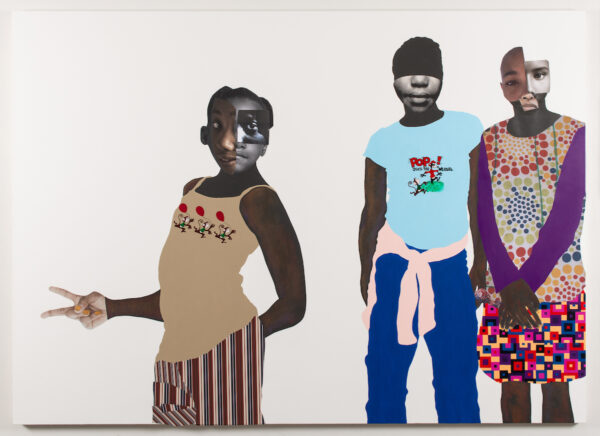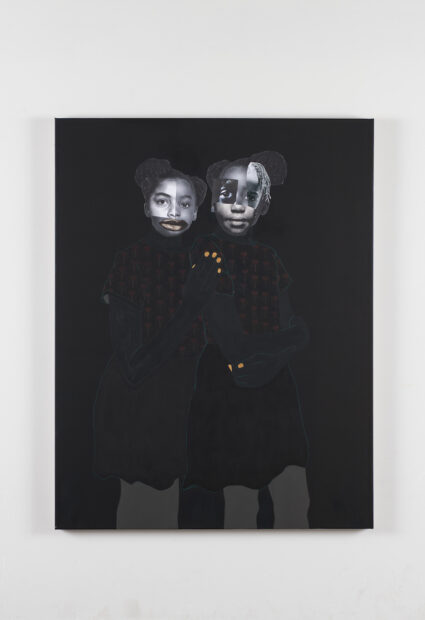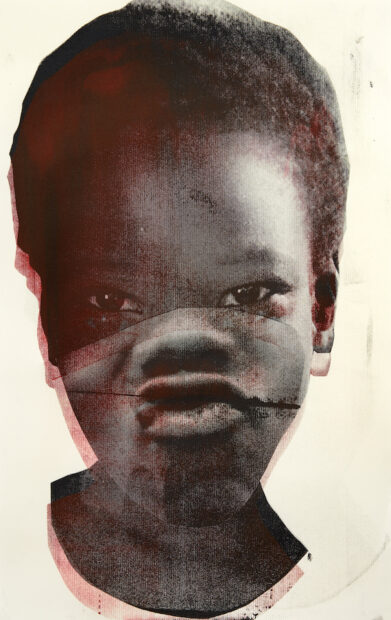
Deborah Roberts, Jamal, 2020. Mixed media collage on canvas. 65 x 45 inches. Artwork © Deborah Roberts. Courtesy the artist; Vielmetter Los Angeles; and Stephen Friedman Gallery, London. Image courtesy The Contemporary Austin. Photograph by Paul Bardagjy.
What we expect from painting is not too different from what was expected of it two centuries ago: a representation of the world we live in at a given time. Of course, the world has changed as has the history of representational artwork, but in many ways, the depictions of landscapes and portraits have adapted to their contexts. Deborah Roberts’ context is very much the America of our lifetimes. Her work does what all good portraiture does, which is to present us with a captured moment of social history. Roberts’ paintings and collages, on view at The Contemporary Austin in a major solo show titled I’m, formally suggest the fragmentations of identity and suggest the complex assemblages of history, ideology, and culture. Her portraits, characterized by distinct figures on expanses of blank, negative space, are inspired by specific individuals and represented by images of African-American children.
Taking influence from artists like Romare Bearden, Hannah Höch, and Wangechi Mutu, Roberts combines found elements from formal archives and Google image searches into fractured and complex representations of individuals. Roberts’ artwork explores Black identity as American identity, visualizing the ideas of self-reflection, double-consciousness, and the criminalization and sexualization of Black bodies. Her point is most effective as we see these symptoms of ideology manifested in children — considered the image of innocence. Innocence is a romantic luxury in America — gifted to some, withheld from others.

Deborah Roberts, The duty of disobedience, 2020. Mixed media collage on canvas. 72 x 100 inches. Artwork © Deborah Roberts. Courtesy the artist; Vielmetter Los Angeles; and Stephen Friedman Gallery, London. Image courtesy The Contemporary Austin. Photograph by Paul Bardagjy.
This work brings to mind several ideas of identity and subjectivity. These portraits return our gaze. We are confronted with questions of how to see oneself in public: how does this differ from our idea of self in private? One overriding theme in Roberts’ work is the idea of American identity — collective and individual identity. American identity is, and always has been, a very suspect construction in which some are visible, others are hidden, and some are both. A major part of identity in this country is defined by one’s proximity to institutions of power. Our social notions of criminality and sexuality have always been tied to racial politics, and Roberts’ work highlights this fact. Fractured bodies, recognizability building and shattering — the formation of an individual representation points to these issues. Roberts makes this connection clear through her portraits of youth — that point in life when individuality is formed, and when sexualization, criminalization, and ideology are imprinted on us.

Deborah Roberts, Portraits: When they look back (No. 3), 2020. Mixed media collage on canvas. 45 x 35 inches. Artwork © Deborah Roberts. Courtesy the artist; Vielmetter Los Angeles; and Stephen Friedman Gallery, London. Image courtesy The Contemporary Austin. Photograph by Paul Bardagjy.
There is a pictorial flatness to these images, in which the figures reside on the paper’s surface plane, that evokes much contemporary painting. Standing or sitting in child-like, casual poses, these large-scale portraits are all set onto white backgrounds, reducing visual noise and focusing our attention on the human figures. The figures don’t appear static. They show up in different parts of the frame; some seem to be entering or exiting the scene, their restlessness captured. We’re confronted with the figures staring right back at us, heightening our consciousness of looking. We understand that these portraits represent actual individuals. This is Roberts’ method; she has portrayed versions of individuals for years — up to recently exclusively girls — and most with a news-worthy backstory. But these new portraits strike a chord as images of personhood itself. Only recently has her work included boys.

Deborah Roberts, Fighting all the ISM, 2019. Mixed media collage on canvas. 72 x 60 inches. Artwork © Deborah Roberts. Courtesy the artist; Vielmetter Los Angeles; and Stephen Friedman Gallery, London. Image courtesy The Contemporary Austin. Photograph by Paul Bardagjy.
Fashion and portrait photography clearly influence Roberts’ compositions, including clipped images and the clothes her figures wear. Rarely drab, these portraits feature bright colors and dazzling patterns, which contrast the simple outlines of their wearers’ forms, and add interesting oscillations between flatness and the illusions of form. While the figures’ arms, legs, or clothing may be painted or collaged, their faces are almost exclusively collaged from found images. These fragments of faces are combined into mosaics — analogous to the complexity of identity. Similarly, in Roberts’ work, perspective is distorted, visually and conceptually, and seems to suggest a moment of coming into completion rather than falling out of it.

Deborah Roberts, I see you (#17 of 24), 2019. Silkscreen on paper. 17 x 11 inches. Artwork © Deborah Roberts. Courtesy the artist; Vielmetter Los Angeles; and Stephen Friedman Gallery, London. Image courtesy The Contemporary Austin. Photograph by Mark Poucher.
Some parts of these figures seem very similar — like recycled parts — which brings to mind stock (or trope) cultural imagery, and ideas like replaceability or interchangeability The mechanical implications of these ideas recall the mechanical nature of assemblage and collage as processes through physical cutting and pasting of mechanically reproduced images.

Deborah Roberts, La’Condrea is a noun., 2020. Silkscreen on paper. 30 x 22 inches. Artwork © Deborah Roberts. Courtesy the artist; Vielmetter Los Angeles; and Stephen Friedman Gallery, London. Image courtesy The Contemporary Austin. Photograph by Paul Bardagjy.
The use of text is direct, and Roberts has used the literal for some time to highlight the discrepancies in our language and between our normative cultural standards. In a departure from her painted and collaged images, on a simple screenprint, the sentence La’Condrea is a noun, in black sans-serif letters, appears with the ubiquitous red, wavy underline beneath the name, signifying a misspelling. The indictment here is that creative names are not recognized by programmed dictionaries. Naming is not an insignificant act — it is a judgment and an act of expression and of freedom. This instance points out the incomprehensibility of not only the name, but also of the person, La’Condrea. Those dictionaries are reflective of the norms of their programmers.
Through August 15, 2021 at The Contemporary Austin at the Jones Center on Congress Avenue.


